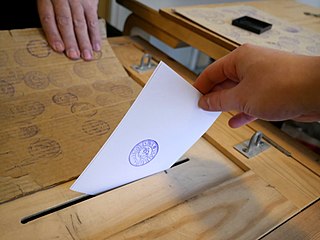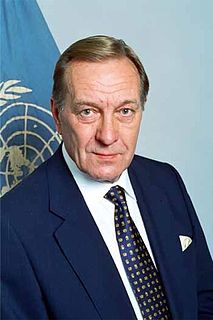
There are four types of elections in Finland. Each Finnish citizen at least 18 years of age has the right to vote in each of the elections, which decide the following: the president, the parliament, the MEPs, and the municipal and city councils.

The Croatian Democratic Union is a conservative political party and the main centre-right political party in Croatia. It is one of the two major contemporary political parties in Croatia, along with the centre-left Social Democratic Party (SDP). It is currently the largest party in the Sabor with 55 seats. The HDZ ruled Croatia from 1990 after the country gained independence from Yugoslavia until 2000 and, in coalition with junior partners, from 2003 to 2011, and since 2016. The party is a member of the European People's Party (EPP). HDZ's leader, Andrej Plenković, is the current Prime Minister of Croatia, having taken office following the 2016 Parliamentary Election.

Parliamentary elections were held in Finland on 16 March 2003. The Centre Party led by Anneli Jäätteenmäki overtook the Social Democratic Party (SDP) to become the largest party in the Eduskunta. This was credited mainly to Jäätteenmäki's powerful leadership and modernization of the party still often viewed as agrarian and conservative by many. However, the SDP actually won some seats and increased its share of the vote, losing in the number of total popular votes only by a few thousand.
Finland Proper is a Finnish constituency. It covers the administrative region of Southwest Finland, with a population of 450,968. Finland Proper elects 17 members to eduskunta.
Kymi is an electoral district represented in the Finnish Eduskunta (parliament). It covers the administrative regions of South Karelia and Kymenlaakso in south-eastern Finland, with a combined population of about 322,000. Kymi currently elects 12 members of the Eduskunta.
Northern Savonia was an electoral district represented in the Finnish Eduskunta (parliament). Since 2013 it has been part of the Savonia Karelia electoral district. It covered the administrative region of Northern Savonia, with a population of about 251,000. Northern Savonia currently elects ten members of the Eduskunta.
North Karelia was an electoral district represented in the Finnish Eduskunta (parliament). In 2013 it was merged with Northern Savonia electoral district to form the Savonia-Karelia electoral district. It covered the administrative region of North Karelia, with a population of 169,722. North Karelia elected six members of the Eduskunta, when in 2005 there were still seven seats.
Oulu is a Finnish constituency represented in eduskunta. It covers the administrative regions of Northern Ostrobothnia and Kainuu, with a combined population of about 459,000. Oulu currently elects 18 members of eduskunta.
Pirkanmaa is a Finnish constituency represented in eduskunta. It covers the administrative region of Pirkanmaa, with a population of 453,978. Pirkanmaa currently elects 18 members of the Eduskunta.
Satakunta is a Finnish constituency represented in eduskunta. It covers the administrative region of Satakunta, with a population of 221,752. Satakunta elects nine members of the Eduskunta.
Southern Savonia was an electoral district represented in the Finnish Eduskunta (parliament). It covered the administrative region of Southern Savonia, with a population of 163,276. Southern Savonia elected six members of the Eduskunta. The electoral district was merged with Kymi to form the new Southeastern Finland district.

Tavastia is a Finnish constituency represented in eduskunta. It covers the administrative regions of Kanta-Häme and Päijät-Häme, with a combined population of about 364,000. Tavastia currently 14 members to eduskunta.
Vaasa is a Finnish constituency represented in eduskunta. It covers the administrative regions of Ostrobothnia, Central Ostrobothnia and Southern Ostrobothnia. Vaasa currently elects 17 members to eduskunta.

Parliamentary elections were held in Finland on 18 March 2007. Early voting was possible from the 7–13 March. The 200 members of the Eduskunta were elected from 15 constituencies.
Parliamentary elections were held in Finland on 20 and 21 March 1983. The elections were widely regarded as a "protest election" because, contrary to expectations, the major parties with the exception of the Social Democratic Party (SDP) performed poorly; the Liberal People's Party (LKP) lost all its seats in the Eduskunta, while the Finnish Rural Party (SMP) more than doubled its seat tally and the Greens won seats for the first time. The SMP's success was credited, at least in part, to voter distaste for some mainstream parties because of political scandals; no significant policy differences emerged in the election campaign. The SDP won 57 seats, the best performance by a party since World War II.
The European Parliament election of 2009 in Finland was the election of the delegation from Finland to the European Parliament in 2009.

Two-stage presidential elections were held in Finland in 1982. The public elected presidential electors to an electoral college on 17 and 18 January. They in turn elected the President. The result was a victory for Mauno Koivisto, the first member of the Social Democratic Party to be elevated to the country's highest post, and his election meant the full integration of Social Democrats into Finnish public life and an end to the postwar dominance of the Centre Party.

Presidential elections were held in Finland in 1988. They were the first elections held under a new system. Previously, the public had elected an electoral college that in turn elected the President. For this election, the public directly elected the President on 31 January and 1 February, but also elected an electoral college that would elect the President if no candidate won over 50% of the popular vote. The college was increased in size from 300 to 301 seats to make a tie less likely, though this was still technically possible, as electors could abstain from voting.











